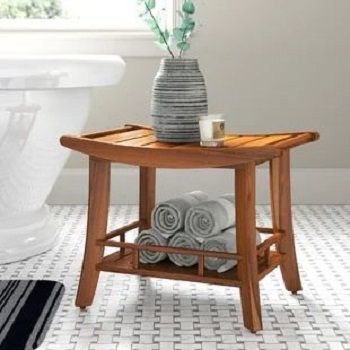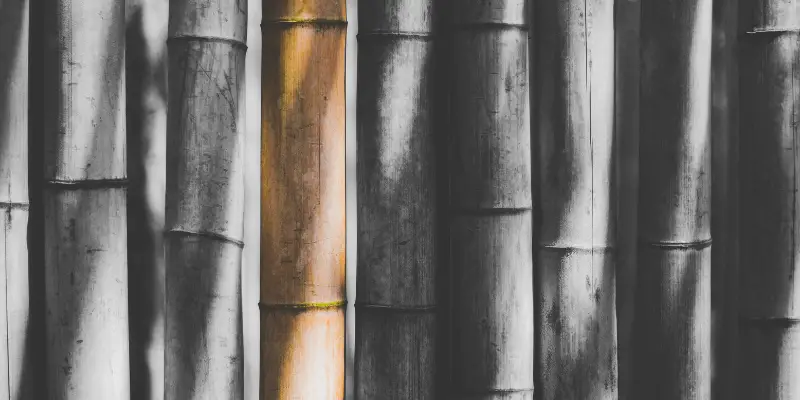I was shopping for a new cutting board, and I decided to go with one made from bamboo. They are advertised as stronger and more durable than regular wooden cutting boards. I became curious about how strong bamboo really is. After researching the topic, I’ve boiled down the important information in this easily absorbable guide.
Bamboo is one of the strongest materials on the planet because of the interlocking system of fibers inside the bamboo stem. These stems are so strong they are often used for light building construction scaffolding, furniture, and weight-bearing poles. Bamboo is 2-3 times stronger than wood.
The strength of bamboo is hidden in its unique shape. Tall objects such as trees and pyramids have a wider base, primarily for sturdiness. The objects always get shallower closer to the top.
Bamboo, on the other hand, has an even stem that is just as durable on top as it is on the bottom. The size difference from the base of the pole to the top tip is almost unrecognizable.
Inside the stem, bamboo grows fibers into different sizes that cascade into alternating patterns. These interlocking fibers are what give the plant so much strength and resistance to pressure.
Engineers have been studying bamboo stems trying to recreate this exceptional property to create stronger manufactured materials.
Let’s continue to explore the strength of bamboo and see how it compares to wood and steel.
What Makes Bamboo So Strong
If you’re looking for the characteristic that defines bamboo’s strength, it’s its hardness.
Bamboo outperforms every other wood on the market. Bamboo is more complex than Oak by 122%.
Apart from using Bamboo for scaffolding, it is also used for walls, decking, plywood, fencing, flooring, and many more.
Is Bamboo Stronger Than Wood
Compared to natural wood, bamboo is relatively stronger. Bamboo is scaffolded when used to build a structure that supports weight, and its strength is created by the tubular structure with solid segments, making them stiff.
In addition, the tight continuous grain that transfers loads creates stiffness that is unique with the strength to weight ratio enabling it to support loads.
Since Bamboo is stronger than wood, you can laminate bamboo to make flooring or wall panels that are quite durable and impact resistant. It is also excellent with golden colors and is being used for home decors like tables, beds, and chairs.
If you’re interested in bamboo furniture, explore our catalog of premium bamboo indoor and outdoor furniture.

Is Bamboo Stronger Than Steel
Plaited Bamboo cables are stronger than steel cables of similar size as wet Bamboo cables increase in strength by as much as 20%.
Bamboo is stronger than steel as it has a greater tensile strength when compared with steel. That means bamboo can withstand more stretching pressure before breaking. It has replaced the majority of wood and steel in construction in parts of Asia, Africa, and South America.
The reason people are choosing to use bamboo instead of steel or wood is due to its affordability. In addition, it is known to slow climate change because of the capacity to capture carbon.
Construction isn’t the only place bamboo is taking over.
Bamboo has regularly been used for making bicycles globally. The only challenge is that bikes made from bamboo have been quite expensive.
However, the prices have reduced, and you can find companies like Greenstart Bikes selling at affordable prices. So, bamboo is stronger than steel. Enough so to replace steel as the primary material used for manufacturing bicycles worldwide.
Advantages of Bamboo:
- They are eco-friendly as there are no herbicides, no fertilizers, no pesticides needed for growing them. All you need is need water, dirt, and sunlight to grow bamboo.
- Bamboos grow pretty fast, up to 3 feet in a day. So you can harvest them every year, unlike trees that have to wait 10 to 15 years for harvesting.
- During harvest time, you don’t chop it like a tree, you cut off what you need, and the rest of the plant continues to grow. It’s like mowing the lawn.
- Since bamboo is grass and not a tree, it grows like a lawn by shooting its roots. As a result, it keeps up soil erosion, benefits the entire ecosystem, and reverses soil depletion.
- Bamboo is renowned for absorbing carbon dioxide globally. It is the best among other plants as it grows fast and big.
- Bamboo is becoming the best cash crop for emerging economies globally as it has no barriers to entry and no harmful by-products.
Disadvantages of Bamboo:
- The downside is that bamboo can be brittle when dry. It makes it lack compressive strength, and it is easily crushed.
- Another downside is that you cannot use nails or screws to fasten Bamboo since the wall thickness is not thick enough to hold a fastener. When you drill the grain, it will just split.
Summary
Bamboo is strong, patient in growing, flexible and more abundant that regular wood. In fact, it’s easier, faster, and less expensive to grow bamboo than wood.
It is not afraid of bending occasionally, but bamboo will always return to its original straightness and be more vital than ever before.
It really is a mystical pant with over 1500 species. Some can be as tall as 40 meters.
Bamboo is resistant to both storms and wind making it an inspiring reference to philosophical, psychological, and spiritual practices. There is a claim that inside the Bamboo plants, there is a secret code that makes them resistant and beautiful, just like its’ end products which are also quite attractive.
Bamboo Group is a collaboration of individuals who love the world’s most sustainable and eco-friendly natural material. We believe every home can benefit from the natural colors and patterns of bamboo. We’re excited to see bamboo grow in popularity and get the recognition it deserves. Years of experience growing bamboo plants have taught us a lot we want to share with the world.



